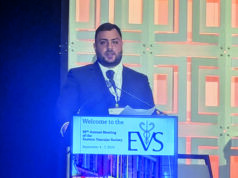
The IN.PACT Admiral drug-coated balloon (DCB) shows promising results in treating femoropopliteal in-stent restenosis (ISR) in a Society for Vascular Surgery (SVS) Vascular Quality Initiative (VQI) registry-based, postmarket surveillance study. This is according to Daniel Bertges, MD, a vascular surgeon from the University of Vermont Medical Center in Burlington, Vermont, who presented interim, 24-month data from the prospective, non-randomized study in a late-breaking clinical trials session at Vascular Interventional Advances (VIVA) 2022 in Las Vegas (Oct. 31–Nov. 3).
Bertges revealed a freedom from target lesion revascularization (TLR) rate of 89.8% at one year and 72% at two years in the “challenging anatomy” of in-stent restenosis within the femoropopliteal artery segment as the headline findings.
The presenter informed VIVA 2022 that he and colleagues conducted a multicenter study involving 300 patients at 43 US sites within the SVS VQI. The primary endpoint was TLR within 12 months post-index procedure, and secondary endpoints—assessed at 12, 24, and 36 months—included all-cause mortality, TLR, target vessel revascularization, major target limb amputation, and technical success, which was defined as successful deployment of the balloon without resulting in occlusion and having residual stenosis ≤30% and resting systolic pressure gradient of <10mmHg, if measured.
Bertges noted that patients were included in the study if they were ≥18 years of age, had undergone single-limb and single-treatment during index procedure and received primary treatment of the ISR lesion with an IN.PACT Admiral DCB, and had de novo or recurrent ISR in the superficial femoral and/or popliteal artery and documented ischemia with Rutherford classification 2, 3, or 4. Those patients who had undergone bilateral femoropopliteal artery repair or had a history of tissue loss in the target limb were excluded. Failure to successfully cross the target lesion was another exclusion criterion.
Giving details of the patients included in the IN.PACT SVS ISR registry, Bertges explained that 20% of patients (60/300) had chronic limb-threatening ischemia (CLTI), 56% (168/300) had diabetes, and 53.7% (161/300) had TASC C–D lesions, among other characteristics.
In his conclusion, the presenter remarked that these results “demonstrate the ability of the VQI to conduct postmarket evaluation of peripheral devices in partnership with industry and federal regulators.”
Speaking to Vascular Specialist following his VIVA 2022 presentation, Bertges commented that one of the main benefits of registry data is that it is “obtained from everyday practice,” and therefore “includes data from a variety of practitioners working to care for a variety of patient populations, as opposed to the sometimes restrictive inclusion and exclusion criteria of clinical trials.”
With reference to a particular benefit of the VQI registry, he stressed that there is “power in numbers,” noting that the VQI includes “several hundred thousand procedures recorded over the past decade or more” and that it continues to accrue tens of thousands of patients annually. “That’s a rich repository of information.”
Furthermore, Bertges referenced the multispecialty nature of the VQI registry— which includes vascular surgeons, cardiologists, radiologists—as another of its strong points, as well as its “continued efforts towards gathering the best longitudinal data on our procedures for our patients.”
Looking ahead to what is next for the study, Bertges informed Vascular Specialist that the researchers are looking to track their results out to three years. “We expect those findings to be reported back to the investigators, to the sponsor, and to our FDA [Food and Drug Administration] regulators in the early part of the summer of 2023, and so we look forward to bringing those results to the vascular community following that.”












